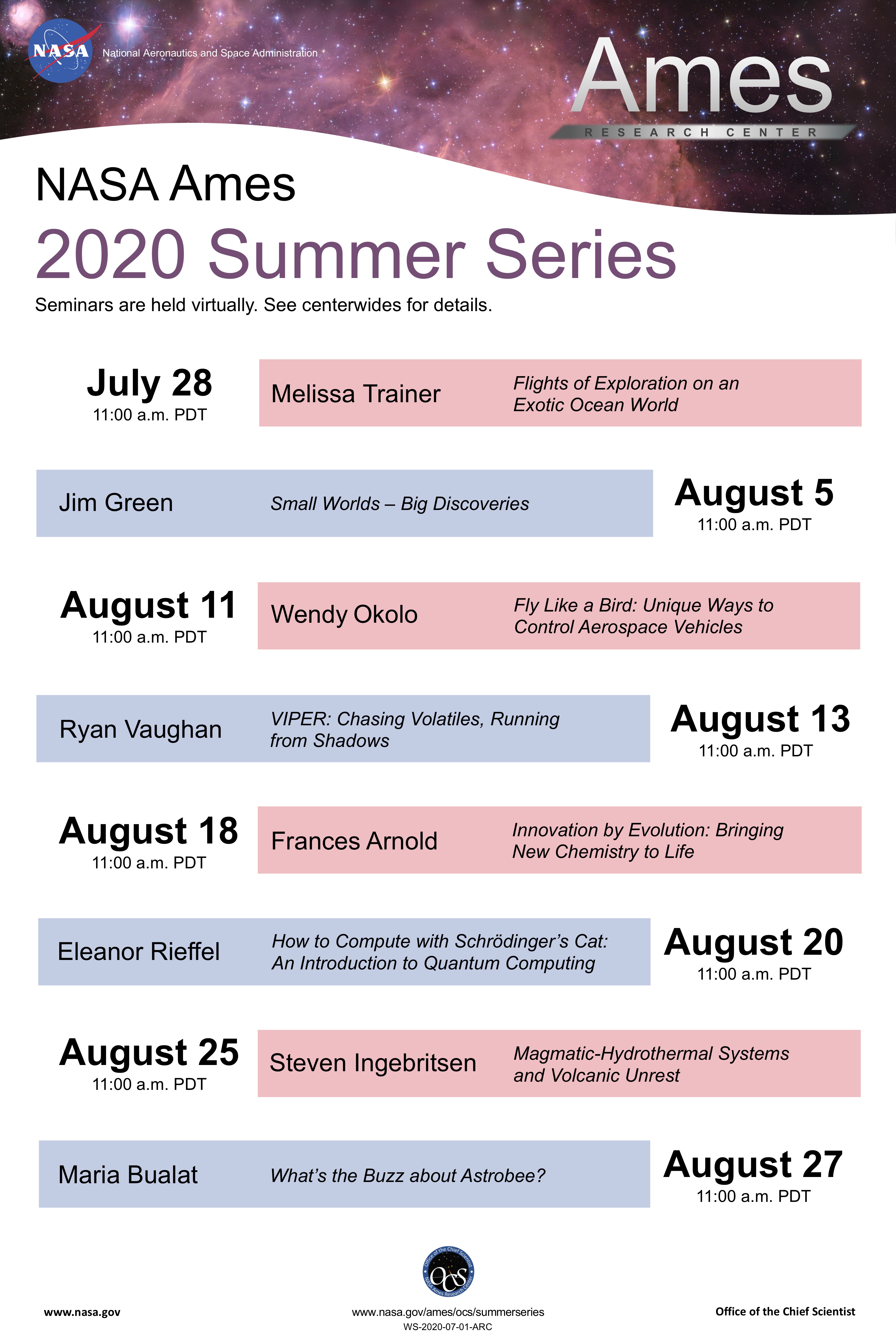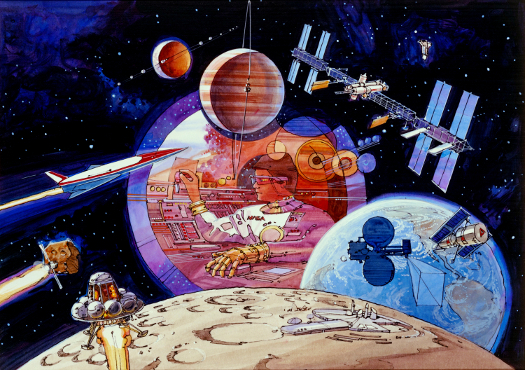2020 Summer Seminar Series
The Office of the Chief Scientist is pleased to announce the 2020 NASA Ames Summer Series! The 2020 Series consists of eight seminars by subject leaders internal and external to NASA and span multiple subject areas including science, technology, and exploration.
 |
Melissa Trainer
Flights of Exploration on an Exotic Ocean World
Life on Earth started in vast oceans of water, but does the same hold true elsewhere in the solar system? Titan, the largest moon of Saturn, is a unique ocean world of liquid methane and is thought to have similar conditions to early Earth. The Dragonfly mission will study Titan’s environment for prebiotic chemistry and characterize its habitability. Please join us as Dr. Melissa Trainer discusses the newest mission in NASA’s New Frontiers Program.
Abstract:
Titan is the only moon in our solar system with a dense atmosphere, which supports an Earth-like hydrological cycle of methane clouds, rain, lakes and seas. Complex organic surface materials may preserve, in a deep freeze, the types of organic chemicals that would have been present on Earth before life developed. Titan’s icy crust floats atop an interior liquid water ocean. The Dragonfly mission to Titan will characterize its habitability and determine how far prebiotic chemistry has progressed in environments known to provide the necessary ingredients for life. The mission comprises a single rotorcraft lander with a sophisticated scientific payload, designed to take advantage of Titan’s environment and achieve wide-ranging exploration by flying to sites in different geologic settings. Launching in 2026 and reaching Titan in 2034, Dragonfly will journey farther than any robotic lander has ever traveled. With one hop every other Titan day (16 Earth days), the rotorcraft will travel from its initial landing site to cover areas several dozen kilometers away during the planned ~3-year mission.
Biography:
Dr. Melissa Trainer is a planetary scientist at NASA’s Goddard Space Flight Center (GSFC) with expertise in the composition of planetary atmospheres and the production of organic molecules and aerosols via in situ synthesis pathways. She has spent more than a decade characterizing the properties of Titan and early Earth aerosol analogs, with publications on the chemical, optical, and isotopic properties of organic hazes. Dr. Trainer is a member of the Mars Science Laboratory Sample Analysis at Mars (SAM) instrument team, for which she led the campaign to conduct the first in situ multi-year study of the seasonal variations of the composition of the Mars atmosphere through surface mass spectrometry measurements. Dr. Trainer currently serves as a Deputy Principal Investigator (PI) for the Dragonfly mission to Saturn’s moon Titan, part of the NASA Planetary Science New Frontiers Program. She is also the lead for the Dragonfly Mass Spectrometer (DraMS), which enables the investigation of Titan’s surface composition and characterization of potential prebiotic chemistry.
Jim Green
Small Worlds – Big Discoveries
Despite their size, small bodies may hold the answers to some of planetary scientists’ biggest questions. Furthering our understanding of these objects will give us insight into the evolution of our solar system and may provide resources for future space exploration. In this seminar, Dr. Green, NASA’s Chief Scientist, will discuss robotic missions to small bodies and what they tell us.
Abstract:
We are in a golden age of planetary exploration with a number of robotic missions that are operating or have been selected to fly to investigate a range of small bodies in the solar system. Small bodies such as asteroids, comets, and Kuiper belts object are very diverse and the more we find out about them the more they appear to be small worlds in their own right to be explored. This short review will discuss the range of current and recent small body missions within the framework of six major categories as to what they can tell us about: 1) The Formation of the Solar System; 2) Delivery of Life Elements to the Planets; 3) The Giant Planet Migration; 4) Processes in an Evolving Solar System; 5) Hazards to Life; and 6) Future Critical Resources. The discoveries from past small body missions have been astounding, demanding that we need to know more. This is that story.
Biography:
NASA’s Chief Scientist Jim Green serves as principal adviser to the NASA administrator and other senior officials on agency science programs, strategic planning, science policy, and the evaluation of related investments. Prior to his appointment as the chief scientist, Dr. Green was the director of the Planetary Science Division at NASA Headquarters from August 2006 to April 2018. Under his leadership, he managed the New Horizons spacecraft flyby of Pluto, the Juno spacecraft to Jupiter, and the landing of the Curiosity rover on Mars just to name a few. Dr. Green was awarded Japan’s Kotani Prize in 1996 in recognition of his international science data management activities and received the NASA Exceptional Achievement Medal for the New Horizons flyby of the Pluto system. He has written over 115 scientific articles in refereed journals and over 50 technical articles. In 2015 Jim helped coordinate the NASA involvement with the film “The Martian.”
Wendy Okolo
Fly like a Bird: Unique Ways to Control Aerospace Vehicles
In just over a century, humanity has gone from developing the first successful airplane to creating a spacecraft capable of delivering payloads to another planet, and more. A key to aerospace vehicle design success is its ability to efficiently control and guide the vehicle in its environment. Traditional methods of flight control effectors have presented multiples challenges that limit their functionality. Dr. Wendy Okolo will present novel control mechanisms for aerospace vehicles and how they compare to their more traditional counterparts.
Abstract:
During aircraft and guided spacecraft flight, conventional control effectors are traditionally used for flight control. For aircraft, these are typically aerodynamic control surfaces while spacecraft have historically relied on reaction control systems to generate moments to trim and steer. Aerodynamic control surfaces work as drag devices and thus, may not be suitable in certain aircraft flight scenarios for which reduced drag is crucial. On the other hand, reaction control systems, used in guided spacecraft entry, don’t have the induced-drag disadvantage but present a different challenge of increased weight due to their associated propellant requirements. This constrains the sizes and masses of scientific payloads that can be safely landed during planetary entry/re-entry missions.
This lecture will showcase alternate trim and control mechanisms for air and space vehicles that demonstrate benefits in comparison to their conventional counterparts. Novel control techniques will be demonstrated for (i) a trailing aircraft in extended formation flight to achieve and demonstrate fuel-savings and (ii) a deployable spacecraft during entry to enable precision targeting and provide mass and volume savings.
Biography:
Dr. Wendy A. Okolo is an aerospace engineering researcher in the Intelligent Systems Division at NASA Ames. She leads the controls team on the STMD Early Career Initiative project Pterodactyl to advance the guidance and control technologies that will enable precision landing for deployable entry vehicles. She is also a sub-project manager on the System-Wide Safety Project, leading a team to develop the monitoring, predictive, and mitigation capabilities that will enable the safe operations of unmanned vehicles in the national airspace.
Prior to joining NASA in 2016, she had spent time at the Air Force Research Laboratory (AFRL) at Wright-Patterson Air Force Base, working on aircraft formation flight for fuel savings and the Advanced Development Programs of Lockheed Martin (Skunkworks), utilizing performance optimizing control techniques to improve fuel efficiencies for the U.S. NAVAIRs Joint Strike Fighter F-35C aircraft.
Dr. Okolo is also the recipient of the 2019 NASA Ames Early Career Researcher Award, the 2019 Black Engineer of the Year Award for Most Promising Engineer in U.S. Government, the 2019 Women In Aerospace Award for Initiative, Inspiration & Impact, and the 2019 U.T. Arlington Distinguished Recent Graduate Award.
Ryan Vaughan
VIPER: Chasing Volatiles, Running from Shadows
Water is an essential resource for human exploration. The Volatiles Investigating Polar Exploration Rover, or VIPER, is a mission to the southern polar region of the Moon which will map and characterize water and other volatile resources. To achieve this goal, VIPER will have to overcome environmental challenges experienced at the polar region, including operating at the permanently shadowed lunar craters and navigating through difficult terrain. Please join us in welcoming Mr. Vaughan for a presentation on the engineering behind VIPER’s ability to operate in the harsh environment of the lunar polar region.
Abstract:
Remote-sensing missions to the Moon, such as the Clementine, Lunar Prospector, and Chandrayaan missions (1994, 1998, and 2008, respectively) and the LRO and LCROSS missions that gathered data from a material plume created by the controlled impacting of the LCROSS rocket stage into the lunar surface (2009), have indicated the presence of potentially significant quantities of hydrogen-bearing molecules in and around permanently shadowed craters near the lunar poles. To understand the distribution of these volatiles and access these unexplored polar regions of the moon, a lunar rover must be designed and operated to navigate rock and crater hazards in a challenging local environment. Low angle solar illumination, wide temperature swings, rapidly changing sun and earth line of site access and multi-path communications effects all have to be taken into account. Traverse planning must also take multiple constraints into account and simultaneously achieve the required measurements, while minimizing risk. The mission is intended to be the first of a series of lunar robotic missions from both governmental and commercial parties, working in conjunction with the commercial parties delivering payload services through NASA’s Commercial Lunar Payload Services (CLPS) program.
Biography:
Ryan Vaughan is a Systems Engineer at NASA Ames Research Center with expertise in robotic spacecraft mission formulation, implementation and operations. He is currently the lead Mission Systems Engineer for the Volatiles Investigating Polar Exploration Rover (VIPER) mission, following having the same role during the development of the Resource Prospector mission, the predecessor of VIPER. Previously, he was the Spacecraft Systems Engineer on the LADEE mission during integration and operations and a systems engineer for the LADEE UVS instrument. Mr. Vaughan also held the division chief position for the Mission Design Division during its transition to the Spaceflight Division in the Engineering Directorate.
Frances Arnold
Innovation by Evolution: Bringing New Chemistry to Life
Directed evolution is a process that harnesses artificial selection to engineer novel biological solutions for pre-determined goals. This technique is used to develop novel enzymes (biological catalysts) for numerous applications, including pharmaceuticals and renewable fuels. Dr. Frances Arnold, who was awarded the 2018 Nobel Prize in Chemistry for pioneering directed enzyme evolution, will present her research and how it can be used to benefit humanity.
Abstract:
Not satisfied with biology’s vast catalyst repertoire, I want to create new enzyme catalysts and expand the chemistry of life. We use the most powerful biological design process, evolution, to optimize existing enzymes and invent new ones, thereby circumventing our profound ignorance of how sequence encodes function. I will show that we can build sustainable, biological routes to important fuels and chemicals. Evolution can also innovate, generating new enzyme catalysts, with a little insight from chemistry. Whole families of new-to-nature enzymes increase the scope of molecules and materials we can build using synthetic biology and move us closer to a sustainable world where human-invented chemistry will be genetically encoded.
Biography:
Frances Arnold is the Linus Pauling Professor of Chemical Engineering, Bioengineering and Biochemistry at the California Institute of Technology. Arnold pioneered directed enzyme evolution, for which she was awarded the Nobel Prize in Chemistry in 2018; she has used directed protein evolution for applications in alternative energy, chemicals, and medicine. Arnold received the Charles Stark Draper Prize of the US National Academy of Engineering in 2011, the US National Medal of Technology and Innovation from President Obama in 2013, and the Millennium Technology Prize in 2016. She has been elected to the US National Academies of Science, Medicine, and Engineering and was appointed to the Pontifical Academy of Sciences in 2019. She co-founded three companies in sustainable chemistry and renewable energy (Gevo, Provivi, Aralez Bio) and serves on several public and private company boards. Arnold earned a B.S. in Mechanical and Aerospace Engineering from Princeton University and a Ph.D. in Chemical Engineering from the University of California, Berkeley.
Eleanor Rieffel
How to Compute with Schrödinger’s Cat: An Introduction to Quantum Computing
We are at the dawn of the quantum computing era. The foundation of conventional computing is a binary logical unit, called a bit, whereas quantum computing takes advantage of a two-state quantum mechanical system, called a qubit. NASA is investigating the potential for quantum computing to revolutionize fields such as optimization of air traffic management or space mission scheduling and machine learning of Earth science data. Please join us in welcoming Dr. Rieffel as she presents her research on quantum computing.
Abstract:
The success of the abstract model of computation (in terms of bits, logical operations, algorithms, and programming languages) makes it easy to forget that computation is a physical process. While our notions of computation and information are grounded in classical mechanics, the physics of our universe is quantum mechanics. A natural question to ask is how computation would change if we instead adopted a quantum mechanical model of computation. In the early 80s, Richard Feynman and Yuri Manin recognized that certain quantum effects could not be simulated efficiently on conventional computers. This observation led researchers to speculate that quantum effects could be used to speed up computation more generally. Slowly, a new picture of computation arose that gave rise to a variety of faster algorithms and novel cryptographic mechanisms. Dr. Rieffel will begin by introducing key concepts underlying quantum computing and correcting misconceptions. Later, she will discuss NASA’s QuAIL team’s research on quantum algorithms, quantum supremacy, quantum programming, quantum-inspired classical algorithms, and the many open research questions remaining, all within the broader context of the rapidly evolving field.
Biography:
Eleanor G. Rieffel leads the Quantum Artificial Intelligence Laboratory at the NASA Ames Research Center, and is a 2020 NASA Ames Associate Fellow. She joined NASA Ames Research Center in 2012 to work on the expanding quantum computing effort. Previously, she performed research in diverse fields at FXPAL, including quantum computation, applied cryptography, image-based geometric reconstruction of 3D scenes, bioinformatics, video surveillance, and automated control code generation for modular robotics. Her research interests include quantum heuristics, evaluation and utilization of near-term quantum hardware, fundamental resources for quantum computation, quantum error mitigation, and applications for quantum computing. She received her Ph.D. in mathematics from the University of California, Los Angeles. She is best known for her 2011 book Quantum Computing: A Gentle Introduction with coauthor Wolfgang Polak and published by MIT press.
Steven Ingebritsen
Magmatic-Hydrothermal Systems and Volcanic Unrest
While volcanic eruptions are difficult to predict, correlations with environmental changes have been observed. Volcanic unrest, the deviation of a volcano from its baseline behavior, includes signs such as seismic activity, surface deformation and gas emissions. The processes associated with volcanic unrest have been shown to change the hydrothermal system around the volcano, altering the water’s chemical composition, temperature and pressure. Dr. Steven Ingebritsen will present the relationship between hydrothermal and magmatic systems and their interactions.
Abstract:
Changes in hydrothermal systems constitute both a valuable signal during volcanic unrest and a major source of noise in other important volcano-monitoring data streams. Magma influences fluid pressures, temperatures, and chemistry; conversely, transport of heat and mass by groundwater affects and often dominates the thermal and chemical regimes of volcanos. Linkages between fluid flow and mechanical deformation are suggested by observations that volcanoes deform in response to changes in water-table elevation and that seismicity can often be related to fluid migration and boiling. Geophysical (seismic and geodetic) and geochemical (gas) signals from magma are modulated by groundwater systems before reaching the observation points. Nonetheless, changes in water pressure, temperature, and chemistry remain, in general, poorly studied phenomena at volcanoes (e.g. National Academy of Sciences, 2017). Here we consider magma-hydrothermal interaction both in general terms and in recent examples from Lassen, California, and Kīlauea Volcano, Hawai’i.
Biography:
Steve Ingebritsen received a BA in Geology at Carleton College and MS and PhD degrees in hydrogeology at Stanford University and has been a member of the U.S. Geological Survey (USGS) since 1980. His research topics include magmatic-hydrothermal systems, crustal permeability, and land subsidence. Steve served a 10-year term as a USGS Branch Chief (1998-2008), managing a $19M/year research program with about 150 full- and part-time employees and contractors. He is a Fellow of both the American Geophysical Union and the Geological Society of America (GSA); recipient of the O.E. Meinzer Award from GSA and the John Hem Award from the National Ground Water Association; and a GSA Birdsall-Dreiss Distinguished Lecturer. Steve is author of the textbook Groundwater in Geologic Processes (Cambridge University Press, 1998, 2nd ed. 2006) and co-Editor of Crustal Permeability (Wiley/AGU, 2016). He is a past co-Editor-in-Chief of Geothermics (1996-1998) and Geofluids (2006-2010), a past Chair of GSA’s Hydrogeology Division, and a Member of the U.S. National Academy of Engineering.
Maria Bualat
What’s the Buzz about Astrobee?
“I do not fear computers. I fear the lack of them.” — Issac Asimov
Human space exploration will not happen alone. Our reach into space will increase with the rate of robotics integration, in part, due to risk reduction and time availability. Currently, on the International Space Station, astronauts’ tasks range from maintenance of the station to scientific experiments. Some of their repetitive tasks can be relieved by robots, enabling the crew to focus on critical tasks. Please join the Office of the Chief Scientist, OCS, in welcoming Maria Bualat who will present the Astrobee robots seminar.
Abstract:
The Astrobee robots began operations on the International Space Station, ISS, in April of 2019. These 32-cm-wide, 9-kg, cube-shaped free flyers are capable of autonomously traversing the US Orbital Segment of the ISS and performing tasks to assist astronauts in their day-to-day activities. The Astrobee Facility also provides an on-orbit testbed for guest scientists desiring to try new technologies in zero-g. This presentation will provide an overview of the Astrobee system and some of its key enabling technologies, including propulsion, navigation, and human interfaces. Additional information and publications can be found on the Astrobee website: https://www.nasa.gov/astrobee.
Biography:
Maria Bualat became the group lead of the Intelligent Robotics Group in 2019, after having served as its deputy since 2005. She joined NASA Ames Research Center in 1987, working in the robotics field since 1995. Bualat has managed projects for NASA’s Science Mission Directorate, Exploration Systems Mission Directorate, Office of the Chief Technologist, and Space Technology Mission Directorate including: ARC Rover Testbed, MIDP instrument integrations and demonstrations on the K9 and K10 planetary rovers, Human-Robot Site Survey, Surface Telerobotics, and Astrobee.


































